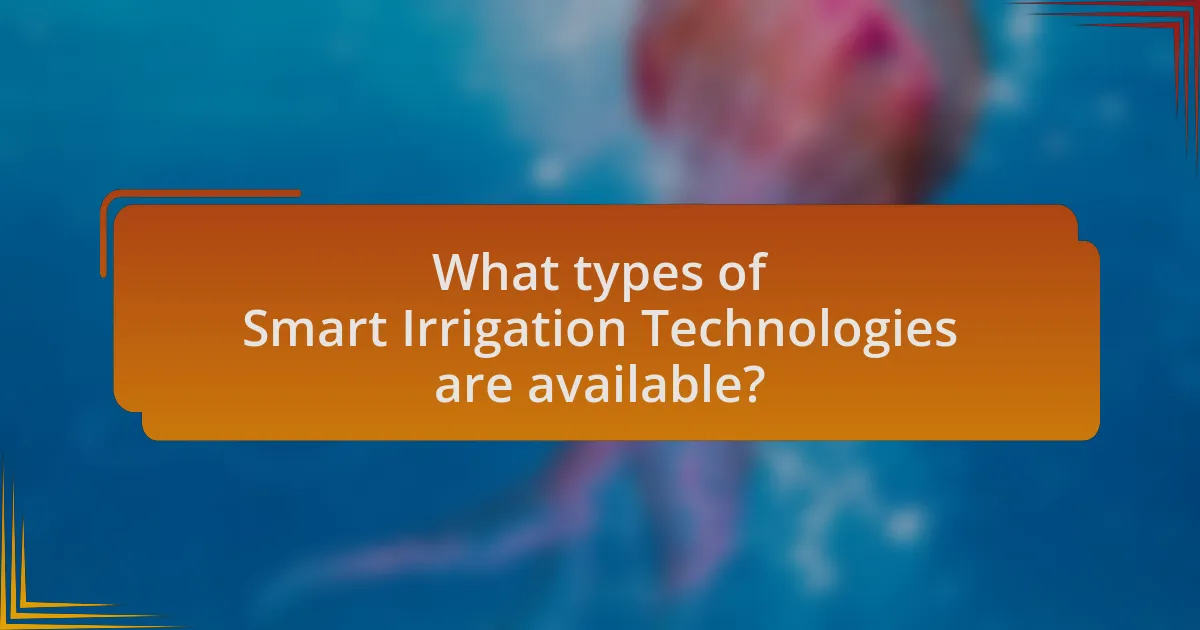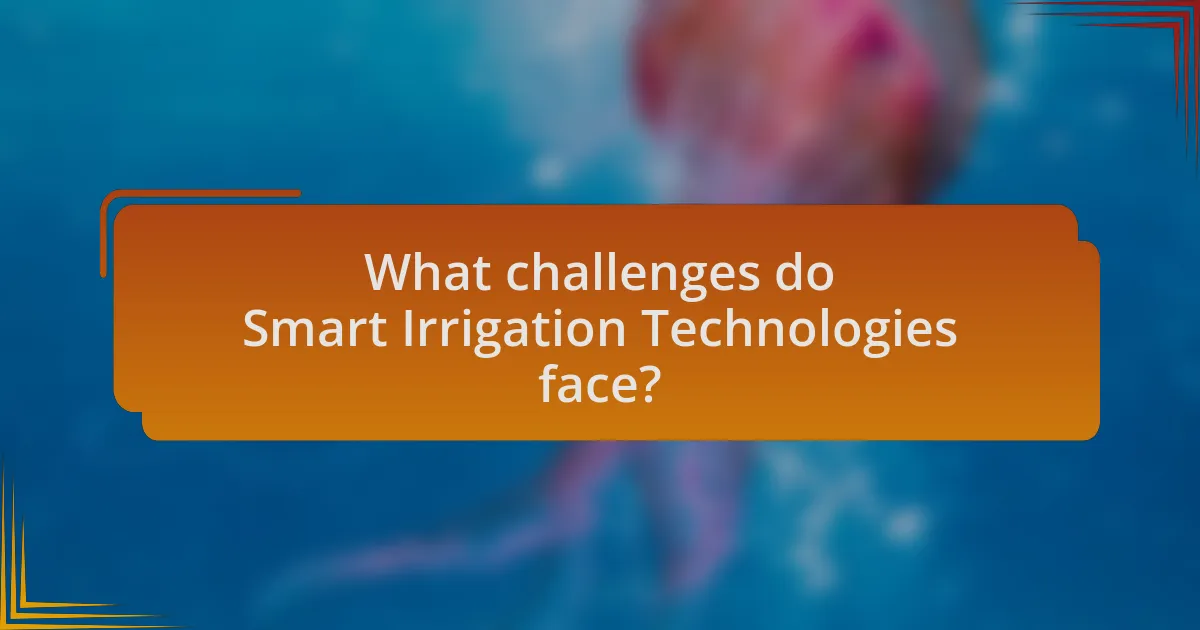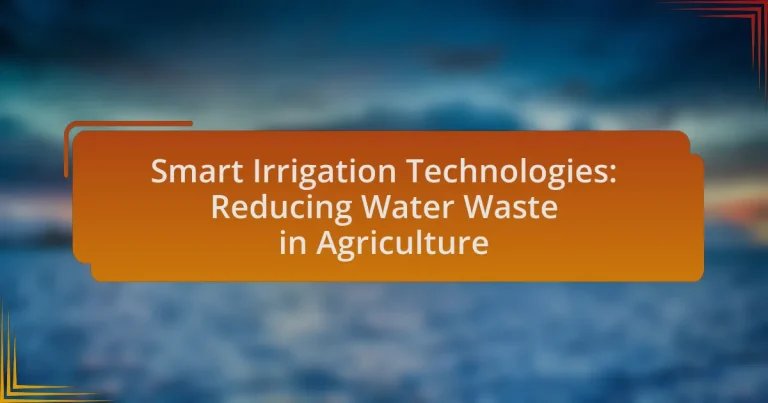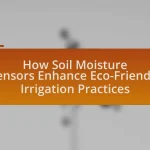Smart irrigation technologies are advanced systems that optimize water usage in agriculture by utilizing sensors, weather data, and automated controls to deliver precise amounts of water to crops. These technologies can reduce water consumption by up to 30-50% while maintaining crop yields, promoting sustainability and resource conservation. Key components include soil moisture sensors, weather stations, and automated irrigation controllers, which collectively enhance decision-making and improve water efficiency. The article also addresses the challenges of adopting these technologies, such as high initial costs and technical complexities, while highlighting future trends and practical tips for effective implementation.
What are Smart Irrigation Technologies?

Smart irrigation technologies are advanced systems designed to optimize water usage in agricultural practices. These technologies utilize sensors, weather data, and automated controls to deliver precise amounts of water to crops based on their specific needs, thereby reducing water waste. For instance, a study by the University of California found that smart irrigation systems can reduce water usage by up to 30% while maintaining crop yields. This efficiency is achieved through real-time monitoring and data analysis, which allows farmers to make informed decisions about irrigation scheduling and water application.
How do Smart Irrigation Technologies function?
Smart irrigation technologies function by utilizing sensors, weather data, and automated systems to optimize water usage in agricultural practices. These technologies monitor soil moisture levels, weather conditions, and plant water requirements, allowing for precise irrigation scheduling. For instance, soil moisture sensors can detect when the soil is dry and trigger irrigation systems to activate only when necessary, significantly reducing water waste. Studies have shown that implementing smart irrigation can lead to water savings of up to 30% compared to traditional irrigation methods, demonstrating their effectiveness in promoting sustainable agricultural practices.
What components are essential for Smart Irrigation Technologies?
Essential components for Smart Irrigation Technologies include soil moisture sensors, weather stations, automated irrigation controllers, and data analytics software. Soil moisture sensors measure the water content in the soil, allowing for precise irrigation scheduling. Weather stations provide real-time weather data, which helps in predicting irrigation needs based on rainfall and temperature. Automated irrigation controllers adjust water delivery based on inputs from sensors and weather data, optimizing water use. Data analytics software processes information from these components to enhance decision-making and improve water efficiency. These components collectively contribute to reducing water waste in agricultural practices.
How do sensors contribute to Smart Irrigation Technologies?
Sensors play a crucial role in Smart Irrigation Technologies by providing real-time data on soil moisture levels, weather conditions, and plant water needs. This data enables precise irrigation scheduling, ensuring that water is applied only when necessary, which significantly reduces water waste. For instance, soil moisture sensors can detect when the soil reaches a specific moisture threshold, prompting irrigation systems to activate only when required. Research indicates that implementing soil moisture sensors can lead to water savings of up to 30% in agricultural practices, demonstrating their effectiveness in optimizing water usage.
Why are Smart Irrigation Technologies important for agriculture?
Smart irrigation technologies are important for agriculture because they optimize water usage, leading to increased efficiency and sustainability. These technologies utilize data-driven approaches, such as soil moisture sensors and weather forecasts, to deliver precise amounts of water to crops, reducing waste and ensuring that plants receive the necessary hydration. Research indicates that smart irrigation can reduce water consumption by up to 30% while maintaining crop yields, demonstrating their effectiveness in promoting resource conservation and enhancing agricultural productivity.
What impact do Smart Irrigation Technologies have on water conservation?
Smart Irrigation Technologies significantly enhance water conservation by optimizing water usage in agricultural practices. These technologies utilize data-driven approaches, such as soil moisture sensors and weather forecasts, to determine the precise amount of water needed for crops, thereby reducing unnecessary water application. Research indicates that implementing smart irrigation systems can lead to water savings of up to 30-50% compared to traditional irrigation methods, as evidenced by a study published in the journal “Agricultural Water Management,” which highlights the effectiveness of these technologies in various agricultural settings.
How do these technologies improve crop yield?
Smart irrigation technologies improve crop yield by optimizing water usage, ensuring that crops receive the precise amount of water needed for growth. These technologies, such as drip irrigation and soil moisture sensors, reduce water waste and enhance nutrient uptake by delivering water directly to the plant roots. Research indicates that implementing smart irrigation can increase crop yields by up to 30% while conserving water resources, as evidenced by studies conducted by the University of California, which found that precision irrigation techniques significantly boosted the productivity of various crops.
What types of Smart Irrigation Technologies are available?

Smart irrigation technologies include drip irrigation, sprinkler systems, soil moisture sensors, weather-based controllers, and smart irrigation apps. Drip irrigation delivers water directly to the plant roots, minimizing evaporation and runoff. Sprinkler systems can be automated to adjust based on weather conditions, while soil moisture sensors provide real-time data on soil hydration levels, ensuring optimal watering. Weather-based controllers utilize local weather data to schedule irrigation, reducing unnecessary water use. Smart irrigation apps allow users to monitor and control their systems remotely, enhancing efficiency. These technologies collectively contribute to significant water conservation in agriculture, with studies indicating that smart irrigation can reduce water usage by up to 50%.
How do drip irrigation systems work?
Drip irrigation systems work by delivering water directly to the root zone of plants through a network of tubing and emitters. This method minimizes evaporation and runoff, ensuring that water is used efficiently. The system typically consists of a mainline that carries water from a source, lateral lines that distribute water to individual plants, and emitters that release a controlled amount of water at a slow rate. Research indicates that drip irrigation can reduce water usage by 30-50% compared to traditional irrigation methods, making it a highly effective technology for conserving water in agriculture.
What are the advantages of using drip irrigation?
Drip irrigation offers several advantages, primarily its efficiency in water usage. This method delivers water directly to the plant roots, minimizing evaporation and runoff, which can lead to water savings of up to 30-50% compared to traditional irrigation methods. Additionally, drip irrigation reduces weed growth by limiting water to the intended plants, thereby decreasing competition for resources. It also promotes healthier plant growth by providing consistent moisture levels, which can enhance crop yields. Furthermore, the system can be automated, allowing for precise control over watering schedules, which is particularly beneficial in regions facing water scarcity.
What crops are best suited for drip irrigation?
Crops best suited for drip irrigation include tomatoes, cucumbers, peppers, carrots, and strawberries. These crops benefit from the precise water delivery that drip irrigation provides, which minimizes water waste and promotes efficient nutrient uptake. Research indicates that drip irrigation can increase crop yields by 20-90% compared to traditional irrigation methods, making it particularly effective for high-value crops that require consistent moisture levels.
What role do automated irrigation systems play?
Automated irrigation systems play a crucial role in optimizing water usage in agriculture. These systems utilize technology to monitor soil moisture levels and weather conditions, allowing for precise water application only when necessary. Research indicates that automated irrigation can reduce water consumption by up to 30% compared to traditional methods, thereby minimizing waste and enhancing crop yield. This efficiency not only conserves water resources but also supports sustainable agricultural practices, making it essential for modern farming.
How do automated systems optimize water usage?
Automated systems optimize water usage by utilizing sensors and data analytics to monitor soil moisture levels and weather conditions in real-time. These systems adjust irrigation schedules and water application rates based on precise data, ensuring that crops receive the optimal amount of water needed for growth while minimizing waste. Research indicates that smart irrigation technologies can reduce water usage by up to 30% compared to traditional methods, as they apply water only when necessary and in the right quantities, thereby enhancing efficiency and sustainability in agricultural practices.
What technologies are integrated into automated irrigation systems?
Automated irrigation systems integrate several technologies, including soil moisture sensors, weather-based controllers, and drip irrigation systems. Soil moisture sensors measure the water content in the soil, allowing for precise irrigation based on actual needs rather than schedules. Weather-based controllers utilize local weather data to adjust irrigation schedules, ensuring that water is only applied when necessary, thus conserving resources. Drip irrigation systems deliver water directly to the plant roots, minimizing evaporation and runoff. These technologies collectively enhance water efficiency and reduce waste in agricultural practices.
What challenges do Smart Irrigation Technologies face?

Smart Irrigation Technologies face several challenges, including high initial costs, technical complexity, and data management issues. The high upfront investment required for advanced sensors and automation systems can deter farmers from adopting these technologies, particularly in regions with limited financial resources. Additionally, the technical complexity of integrating various components and ensuring compatibility can pose significant hurdles for users. Data management challenges arise from the need to analyze large volumes of data generated by these systems, which can overwhelm users lacking the necessary expertise or resources. These factors collectively hinder the widespread adoption and effectiveness of Smart Irrigation Technologies in agriculture.
What are the common barriers to adopting Smart Irrigation Technologies?
Common barriers to adopting Smart Irrigation Technologies include high initial costs, lack of technical knowledge, and limited access to reliable data. High initial costs deter many farmers from investing in these technologies, as they may not see immediate financial returns. Additionally, a lack of technical knowledge can hinder effective implementation and operation, leading to underutilization of the technology. Limited access to reliable data, such as soil moisture levels and weather forecasts, further complicates the adoption process, as farmers may struggle to make informed decisions about irrigation practices. These factors collectively impede the widespread adoption of smart irrigation solutions in agriculture.
How does cost affect the implementation of these technologies?
Cost significantly influences the implementation of smart irrigation technologies by determining the affordability and accessibility for farmers. High initial investment costs can deter adoption, especially among small-scale farmers who may lack the financial resources to invest in advanced systems. For instance, a study by the Food and Agriculture Organization (FAO) indicates that the upfront costs of smart irrigation systems can range from $1,000 to $10,000 per hectare, which can be prohibitive for many agricultural producers. Additionally, ongoing maintenance and operational costs further impact the long-term viability of these technologies, as farmers must weigh these expenses against potential water savings and increased crop yields. Therefore, cost directly affects both the decision-making process and the overall success of implementing smart irrigation solutions in agriculture.
What technical challenges do farmers encounter?
Farmers encounter several technical challenges, including the integration of smart irrigation technologies, data management, and system maintenance. The adoption of smart irrigation systems often requires significant investment in technology and infrastructure, which can be a barrier for many farmers. Additionally, managing the data generated by these systems can be complex, as farmers need to interpret and utilize this information effectively to optimize water usage. Furthermore, maintaining the technology, including sensors and automated systems, can pose challenges due to potential malfunctions or the need for regular updates. These challenges are supported by studies indicating that while smart irrigation can reduce water waste, the initial technical hurdles can hinder widespread adoption among farmers.
How can farmers overcome these challenges?
Farmers can overcome challenges related to water waste by implementing smart irrigation technologies such as drip irrigation and soil moisture sensors. These technologies enable precise water application, reducing excess usage and ensuring crops receive the optimal amount of water. For instance, drip irrigation systems can reduce water usage by up to 60% compared to traditional methods, as reported by the Food and Agriculture Organization. Additionally, soil moisture sensors provide real-time data, allowing farmers to irrigate only when necessary, further minimizing waste.
What resources are available for farmers to learn about Smart Irrigation?
Farmers can access various resources to learn about Smart Irrigation, including online courses, workshops, and agricultural extension services. Online platforms like the USDA’s Sustainable Agriculture Research and Education (SARE) program offer educational materials and webinars focused on smart irrigation techniques. Additionally, universities often provide extension programs that include hands-on training and resources tailored to local agricultural practices. Research articles and publications from organizations such as the American Society of Agricultural and Biological Engineers (ASABE) also serve as valuable references for understanding the latest advancements in smart irrigation technologies.
What best practices can enhance the effectiveness of Smart Irrigation Technologies?
Implementing soil moisture sensors is a best practice that enhances the effectiveness of Smart Irrigation Technologies. These sensors provide real-time data on soil moisture levels, allowing for precise irrigation scheduling based on actual plant needs rather than fixed schedules. Research shows that using soil moisture sensors can reduce water usage by up to 30% while maintaining crop yield, as evidenced by a study conducted by the University of California, which found that smart irrigation systems utilizing these sensors significantly improved water efficiency in agricultural practices. Additionally, integrating weather data into irrigation management systems further optimizes water use by adjusting irrigation schedules based on rainfall forecasts and temperature, thereby preventing over-irrigation.
What are the future trends in Smart Irrigation Technologies?
Future trends in smart irrigation technologies include the increased use of artificial intelligence and machine learning to optimize water usage based on real-time data. These technologies enable precise monitoring of soil moisture levels, weather conditions, and crop needs, leading to more efficient irrigation practices. For instance, a study by the University of California found that AI-driven irrigation systems can reduce water consumption by up to 30% while maintaining crop yields. Additionally, the integration of IoT devices will facilitate remote management and automation of irrigation systems, allowing farmers to make data-driven decisions quickly.
How is technology evolving to further reduce water waste?
Technology is evolving to further reduce water waste through advancements in smart irrigation systems that utilize sensors, data analytics, and automation. These systems monitor soil moisture levels and weather conditions in real-time, allowing for precise water application only when necessary. For instance, a study by the University of California found that smart irrigation can reduce water usage by up to 30% compared to traditional methods. Additionally, the integration of machine learning algorithms enables predictive analytics, optimizing irrigation schedules based on crop needs and environmental factors, thereby minimizing excess water use.
What innovations are on the horizon for Smart Irrigation?
Innovations on the horizon for smart irrigation include the integration of artificial intelligence, advanced sensor technology, and real-time data analytics. These advancements enable more precise water management by allowing systems to adapt to changing environmental conditions and crop needs. For instance, AI algorithms can analyze weather patterns and soil moisture levels to optimize irrigation schedules, significantly reducing water waste. Additionally, the use of IoT devices facilitates remote monitoring and control, enhancing the efficiency of irrigation practices. According to a report by the Food and Agriculture Organization, implementing these technologies can lead to water savings of up to 30% in agricultural practices.
What practical tips can farmers implement for effective Smart Irrigation?
Farmers can implement several practical tips for effective Smart Irrigation, including utilizing soil moisture sensors to determine the optimal watering times and amounts. These sensors provide real-time data on soil moisture levels, allowing farmers to irrigate only when necessary, which can reduce water usage by up to 30%. Additionally, adopting drip irrigation systems can deliver water directly to the plant roots, minimizing evaporation and runoff. Research indicates that drip irrigation can save 50% more water compared to traditional methods. Furthermore, integrating weather forecasting tools can help farmers adjust their irrigation schedules based on predicted rainfall, further conserving water resources.


